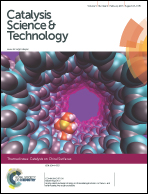Highly active and durable silica-coated Pt cathode catalysts for polymer electrolyte fuel cells: control of micropore structures in silica layers
Abstract
Carbon nanotube (CNT)-supported Pt catalysts (Pt/CNT) for use as cathode components in polymer electrolyte fuel cells (PEFCs) were covered with silica layers to prevent particle size increases during operation of the PEFC, either through the sintering of the Pt particles or the dissolution and redeposition of Pt ions. The formation of silica layers by the successive hydrolysis of 3-aminopropyltriethoxysilane (APTES) and tetraethoxysilane (TEOS) significantly improved the durability of the Pt/CNT catalysts under cathodic conditions, although the activity of the silica-coated material for the oxygen reduction reaction was slightly lower than that of the uncoated catalyst. In contrast, a silica-coated Pt/CNT catalyst prepared by the successive hydrolysis of APTES and TEOS in the presence of NH2–(CH2)n–NH2 (n = 6, 8 and 10) exhibited both high catalytic activity and excellent durability. The NH2–(CH2)n–NH2 added during the silica coating process worked as a template for the formation of micropores in the silica layers and the resulting pore structures enhanced the diffusion of both reactants and products during oxygen reduction on the silica-coated Pt/CNT catalysts.


 Please wait while we load your content...
Please wait while we load your content...